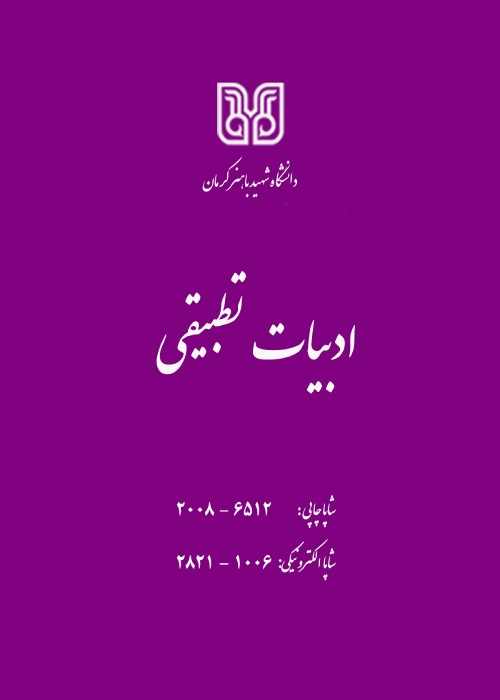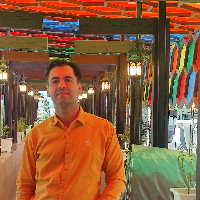A Comparative Study of the most significant Components of Romanticismin the Poems of Louis Aragon and Ahmad Shamloo
Literary schools and their varied forms are the result of the alliance between society and literary texts. The dynamic, evolving and constantly changing society of the West has provided the grounds for the emergence of various literary schools; A concept that is not very common in the East in general and in our land, Iran. However, the salient feature of the contemporary world: its "ruralization", in other words, the expansion of media and cultural relations, is itself a ground for familiarity and, consequently, the expansion of literary schools in various geographical-cultural realms. Thus, by quoting literary texts, both in our culture and in the West, harmonies and homogeneities can be achieved; The result of what we have said is this: a comparative study of literary schools with the texts of Persian literature is a necessary enterprise in order to increase literary knowledge and through it, to better understand a person in different historical periods and different fields of thought.
This study is based on the descriptive analysis method by using library research and studying the most significant components of romanticism in the poems of Louis Aragon and Ahmad Shamloo. Critics believe that the school of Romanticism had a great influence on nineteenth-century French literature, and on the other hand, contemporary Iranian literature was clearly influenced by French literature in form and content; Accordingly, the authors of the present study intend to conduct a comparative study on the elements of the school of Romanticism in the poems of Ahmed Shamloo and the poems of Louis Aragon, the prominent poet of the twentieth century France. The main focus of the research is to answer the following question:What are the most prominent components of the school of Romanticism in the poems of Louis Aragon and Ahmad Shamloo? And consequently, how does Aragon and Shamloo exhaust the principles of the Romantic school in two different cultural geographies?
In the history of schools of thought, Romanticism is one of the most important philosophical, artistic and literary movements, which "rejects the classical laws and rationalism, seeks to reform thought and expression" and "It praises emotion, imagination, dreams, greed and spirituality. (FLAUBERT, 1887–1893: 1/37) This school emerged in the late eighteenth century in England, Germany, France, and northern Europe. Important features of this school include attention to human feelings and emotions, sadness, justice and freedom, excessive influence of environments, events and heroism; Some literary critics believe that the importance of Romanticism is due to its tremendous impact on Western thought and the world, and that all the changes of the nineteenth and twentieth centuries are derived from the principles of this school. (Berlin, 1394: 20) But before that, it should be noted that the emergence of any school requires some areas: the destruction of the old system, the industrial revolution, urban growth, the growth of the middle class, the expansion of literacy and other emerging phenomena in the emergence of the school Romanticism was effective in Europe (see: Khajat, 1391: 7 and Zarghani, 1387: 217). In terms of content and structure, Ahmad Shamloo was influenced by French poets such as Paul Éluard and Louis Aragon, and much of his poetry was based on the main components of the Romantic school. Argon, on the other hand, was deeply influenced by classical Persian literature. The authors intend to study the most prominent components of Romanticism in the poems of Louis Aragon and Ahmad Shamloo by adopting a comparative approach while highlighting meaningful similarities and differences. Some of the components examined in this study are: imagination, personality and individualism, naturalism, utopianism, travel, love and death.The most important component that distinguishes Romanticism from Classicism is the element of "imagination." Using the element of imagination, romantic poets are able to "depict the world in such a way that the infinite is within the finite, and the ideal is within the reality, and at the same time it can reveal all its beauties." (Forrest, 2014: 65) In their surprising view, imagination is a representation of truth and thus, has a close relationship with a particular insight, perception or inspiration. (Bavere, 2017: 61). Another principle of the school of Romanticism is the reflection of the inner emotion and sorrow of the poet / writer; Thus, the poet opens the door of his inconsolable heart to his audience and introduces them to his deepest feelings. Sometimes romantics "limit poetry to excitement and emotions that have no artistic originality, are superficial, simple and underdeveloped, and do not have enough depth and ambiguity to have a profound and adequate effect" (Baghinejad, 2010: 58). In Romantic literature, the concept of love is prominent in the poetry of poets; In their views, love is such an inner love combined with imagination, lust and nympholepsy; Romantics consider their beloved as idol to be worshiped and sanctified;; "In this way women enter the literature of this age who have nothing in common with ordinary women; "There are things like fairies, forest nymphs, sailors, wild queens and princes of the East, mysterious gypsies, strange enough and untamable people." (Priestley, 2012: 1391). Consideration on death is an impartible part of human life and has dominated the human mind and soul in various ways throughout history. From the beginning of life, human beings have resorted to superstitions, religion and philosophy to deal with this ambiguous and frightening phenomenon and have tried to understand and digest this important natural phenomenon by relying on science and art. One of the most famous traits of romanticists is the intense tendency to grief and depression and the remembrance of death (Dethwish). By seeking solitude, they sought to explore the mysterious world of the unconscious and the dark aspects of the mind, and to meditate in the depths of their being; Other components of the Romanticism and its reflection in poetry is naturalism and its connection with imagination. Romantic poets, considering natural phenomena and sanctifying the universe beings, intended to use nature as a source for unseen revelations and the emergence of godsend.
The analysis of poetic examples shows a kind of harmony and homogeneity in the poetry of the two poets; Using the element of imagination, both poets have portrayed mysterious manifestations of romanticism for their audiences; As well, these two have turned to a happy childhood and, by combining emotion and imagination, vitalize the inspiring memories of childhood for their audience; In the works of both poets, the excitement and feeling is more the kind of suffering, anger and severe pain indicating the bad environment around and the unhealthy situation of the country. Aragon witnesses the occupation of the homeland and the killing of innocent French people, and expresses its deep sorrow at seeing the horrific and violent scenes. Shamloo also speaks openly and overtly in expressing the poverty, deprivation, displacement and ignorance of the people of his time, and considers his poems as a course of hope to reflect the suppressed hatred of oppressed human beings and to cry out to human beings; In the expression of love, both poets consider their beloved wife as a beautiful and perfect queen who has been a source of comfort for poets and relieving their sorrow and boredom. After marrying his wife Elsa, Louis Aragon wrote most of his poems to his wife and in her name. As Shamlou, After marrying his wife Aida, has made his love the main theme of many of his love poems and has taken the title of two collections of his poems from his name; Utopia and Dethwish are among the paradoxical categories in the poetry of these two: Aragon and Shamloo both regret the loss of genuine human values and seek utopia to achieve their dreams and aspirations, but in Finally, both consider death a source of comfort. using imagination and discernment, Both poets try to portray their feelings and emotions in the form of drawing natural phenomena for their audiences with detail and care in the phenomena of nature; In the subject of individualism, both poets consider themselves as the heroes of their poems and express their sorrow and feelings with full courage, regardless of any limitations.
- حق عضویت دریافتی صرف حمایت از نشریات عضو و نگهداری، تکمیل و توسعه مگیران میشود.
- پرداخت حق اشتراک و دانلود مقالات اجازه بازنشر آن در سایر رسانههای چاپی و دیجیتال را به کاربر نمیدهد.



